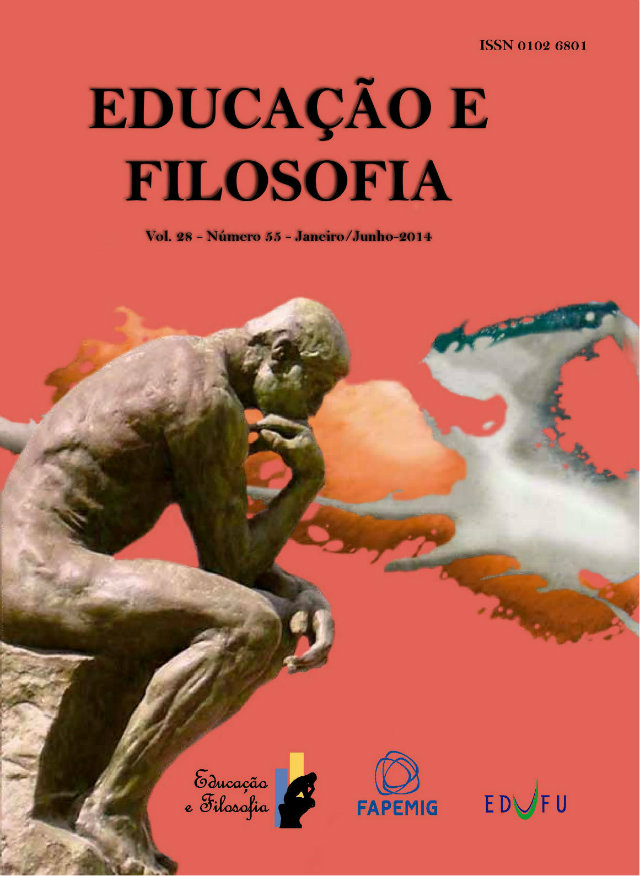La incapacidad mayeútica del arte en la sociedad platónica
DOI:
https://doi.org/10.14393/REVEDFIL.issn.0102-6801.v28n55a2014-p255-280Palabras clave:
Platón, Arte, Pintura, Educación, Mayéutica, CensuraResumen
La incapacidad mayeútica del arte en la sociedad platónica
Resumen: La relación entre Platón y el arte de su tiempo es un tema bien conocido desde hace décadas. Si bien parece claro que Platón estableció uma definición perenne sobre qué es el arte y su proceso creativo en la antigua Grecia, sin embargo debemos prestar atención a la función que para Platón el arte tenía en su sociedad ideal. ¿Para qué el arte? En su proyecto educativo -basado en la mayéutica como eje fundamental del aprendizaje - el arte está sometido al dictamen y censura de las demás ciencias empíricas. Este artículo pretende evaluar la verdadera relevância educativa que el proceso artístico tenía para Platón a través de un análisis crítico de la sociedad planteada por el filósofo ateniense.
Palabras clave: Platón; Arte; Pintura; Educación; Mayéutica; Censura.
La incapacidad mayeútica del arte en la sociedad platónica
Abstract: The relationship between Plato and the art of his time is a well known subject for decades. While it seems clear that Plato established a perpetual definition of what is art and the creative process in ancient Greece, however we must pay attention to the role that art had in Plato's ideal society. Why art? In its education process - based on maieutic as a fundamental learning motive - art is a subject to opinion and censorship of other empirical sciences. This article aims to evaluate the true educational relevance that Plato had artistic process through a critical analysis of society presented by the Athenian philosopher.
Keywords: Plato; Art; Painting; Education; Maieutic; Censorship.
Data de registro: 13/03/2013
Data de aceite: 20/11/2013
Descargas
Citas
AUERBACH, E. Mímesis: La representación de la realidad en la literatura occidental. México: Fondo de Cultura Económica, 1987.
BABUT, D. Paradoxes et énigmes dans l'argumentation de Platon au livre X de la République. In: BRUNSCHWIG, J. (org.). Historie et Structure. Hommages á Victor Goldschmidt. Paris: Vrin, 1985.
_________. Sur la notion d’Imitation dans les doctrines esthétiques de la Gréce classique. REG, n. 98, p. 72-92, 1985. https://doi.org/10.3406/reg.1985.1409
BAEUMLER, A. Ästhetik.Berlin: Oldenbourg, 1934.
BERTRAND, J-M. De l’écriture à l’oralité:Lectures des Lois de Platon. Paris: Publications de la Sorbonne, 1999. https://doi.org/10.4000/books.psorbonne.22727
BOYD, J. D. The Function of Mimesis and Its Decline. Cambridge: Harvard University Press, 1968. https://doi.org/10.4159/harvard.9780674733879
BYVANCK, A. W. Platon et l’art grec. Bulletin Antieke Beschaving, n. 30, p. 35-39, 1955.
COLLINGWOOD, R. G. Plato’s Philosophy of Art. Mind, v. 34, n. 134, p. 154-172, 1925. https://doi.org/10.1093/mind/XXXIV.134.154
CORLETT, J. A. Interpreting Plato’s Dialogues. CQ, New Series, v. 47, n. 2, p. 423-437, 1997. https://doi.org/10.1093/cq/47.2.423
DAVIDSON, J. Greek Drama: image and audience(s). BIClassStud, v. 48, p. 1-15, 2005. https://doi.org/10.1111/j.2041-5370.2005.tb00251.x
DAVIS, W. M. Plato on Egyptian Art. JEgyptArchaeology, v. 65, p. 121-127, 1979. https://doi.org/10.1177/030751337906500121
DE ANGELI, S. Mimesis e Techne. QUCC, n. 57, p. 27-45, 1988. https://doi.org/10.2307/20546936
DELATTE, A. Les conceptions de l’enthousiasme chez les philosophes présocratiques. Paris: Les Belles Lettres, 1934. https://doi.org/10.3406/antiq.1934.3130
DELEUZE, G. Platón y el simulacro. Lógica del sentido. Barcelona: Paidós, 2005.
DEMAND, N. Plato and the Painters. Phoenix, v. 29, p. 1-20, 1975. https://doi.org/10.2307/1087580
DEMOS, R. Was Plato a Fascist? Classical Weekly, v. 35, p. 243, oct.1941/jun.1942. https://doi.org/10.2307/4341473
DERRIDA, J. Dissémination. Paris: Seuil, 1972.
DONOVAN, B. R. The Do-It-Yourself in Plato’s Republic. AMJPhilology, v. 124, n. 1, p. 1-19, 2003. https://doi.org/10.1353/ajp.2003.0018
DODDS, E. R. The Ancient Concept of Progress and other Essays on Greek Literatura and Belief. Oxford: Clarendon Paperbacks, 1973.
DUBOIS, P. The History of the Impossible: Ancient Utopia. ClassicalPhilol, v. 101, n. 1, p. 1-15, 2006. https://doi.org/10.1086/505668
DYSON, M. Poetic Imitation in Plato Republic 3. Antichton, n. 22, p. 42-53, 1988. https://doi.org/10.1017/S0066477400003610
EDMONDS, R. G. Socrates the Beautiful: Role Reversal and Midwifery in Plato’s Symposium. TAMPhilolAssoc, n. 130, p. 261-285, 2000. https://doi.org/10.1353/apa.2000.0004
FLASHAR, H. Der Dialog Ion als Zeugnis platonischer Philosopie. Berlin: Akademie-Verlag, 1958.
_________. Die Klassizistische Theorie der Mimesis. Le Classicisme a Rome, n. 25, p. 79-111, 1978.
GIL, L. Censura en el mundo antiguo. Madrid: Alianza Editorial, 1961.
GILBERT, A. H. Did Plato Banish the Poets or the Critics? StudPhilol, v. 36, p. 1-19, 1939.
GILBERT, K. The Relation of the Moral to the Aesthetic Standard in Plato. PhilosRev, v. 43, n. 3, p. 279-294, 1934. https://doi.org/10.2307/2179703
GODEL, R. Platon a Héliopolis d’Égypte. Paris: Les Belles Lettres, 1956. https://doi.org/10.3406/bude.1956.3717
GOLDEN, L. Plato’s Concept of Mimesis. BritJAesthet, v. 15, n. 2, p. 118-131, 1975. https://doi.org/10.1093/bjaesthetics/15.2.118
GOMBRICH, E. H. Art and Illusion: A Study in the Psychology of Pictorial Representation. Washington: Phaidon Press, 1959.
GRIFFIN, J. The Social Function of Attic Tragedy. CQ, v. 48, n. 1, p. 39-61, 1998. https://doi.org/10.1093/cq/48.1.39
GRISWOLD, C. The Ideas and the Criticism of the Poetry in Plato’s Republic, Book 10. JHistPhilos, v. 19, n. 2, p. 135-150, 1981. https://doi.org/10.1353/hph.2008.0101
HALL, R. W. Plato’s Theory of Art: A Reassessment. JAesthetArtCritic, v. 33, n. 1, p. 75-82, 1974. https://doi.org/10.1111/1540_6245.jaac33.1.0075
HALLIWELL, S. The Aesthetics of Mimesis: Ancient Texts and Modern Problems. Princeton: University Press, 2002. https://doi.org/10.1515/9781400825301
HUBER-ABRAHAMOWICZ, E. Das Problem der Kunst bei Platon.Winterthur: Keller, 1954.
KEULS, E. Plato and Greek Painting. Leiden: Brill, 1978. https://doi.org/10.1163/9789004450776
KOLLER, H. Die Mimesis in der Antike: Nachahmung, Darstellung, Ausdruck. Berna: Francke, 1954.
KRÜGER, J. (Ed.). Ästhetik der Antike. Berlin-Weimar: Laufbau-Verlag, 1964.
LADRIERE, C. The Problem of Plato's Ion. JAesthetArtCritic, v. 10, n. 1, p. 26-34, 1951. https://doi.org/10.1111/1540_6245.jaac10.1.0026
LESHER, J. H. The Afterlife of Plato’s Symposium. ClassicalJ, v. 100, n. 1, p. 75-87, 2004.
LIMINTA, M. T. Il problema della Belleza in Platone: Analisis e interpretazioni dell "Ippia Maggiore". Milán: Vita e Pensiero, 1998.
LIPPMAN, E. A History of Western Musical Aesthetics.Londres: University of Nebraska Press, 1992.
LYONS, J. Structural Semantics: An Análisis of Part of the Vocabulary of Plato. Oxford: Blackwell, 1972.
MASTRANGELO, M.; HARRIS, J. The Meaning of Republic 606a3-b5. CQ, v. 47, n. 1, p. 301-305, 1997. https://doi.org/10.1093/cq/47.1.301
MCKEON, R. Literary Criticism and the Concept of Imitation in Antiquity. ModPhilology, v. 34, n. 1, p. 1-35, 1936. https://doi.org/10.1086/388216
MORAUX, P. La "Mimesis" dans les théories anciennes de la danse, de la musique et de la poésie. LEC, v. 23, n. 1, p. 3-13, 1955.
MARZOA, F. M. Ser y diálogo:Leer a Platón. Madrid: Istmo, 1996.
MÁSMELA, C. Dialéctica de la imagen: Una interpretación del Sofista de Platón. Barcelona: Antropos Editorial, 2006.
MOORE, J. D. The Dating of Plato's Ion. GreekRomanByzantin, v. 15, n. 4, p. 421-439, 1974.
MORGAN, M. The Continuity Theory of Reality in Plato's Hippias Major. JHistPhilos, v. 21, n. 2, p. 133-158, 1983. https://doi.org/10.1353/hph.1983.0039
MORROW, G. R. Plato’s Cretan City. Princeton: Princeton University Press, 1960.
MURRAY, P. Plato on Poetry: Ion; Republic 376e-398b9; Republic 595-608b10. Cambridge: University Press, 1996.
NETTLESHIP, R. L. Lectures on the Republic of Plato. London: MacMillan, 1937.
NOTOMI, N. The Unity of Plato’s Sophist: Between the Sophist and the Philosopher. Cambridge: University Press, 1999. https://doi.org/10.1017/CBO9781107297968
OATES, W. J. Plato's Philosophical Creative Artist. ClassicalWeekly, v. 35, p. 247, oct. 1941/jun. 1942. https://doi.org/10.2307/4341478
OVERBECK, T. Die Antiken Schriftquellen zur Geschichte der bildenden künste bei den Griechen. Hildesheim: Georg Olms 1959.
PARTEE, M. H. Plato’s Banishment of Poetry. JAesthetArtCritic, v. 29, n. 2, p. 209-222, 1970. https://doi.org/10.2307/428602
PANOFSKY, E. Idea: Contribución a la historia de la teoría del arte. Madrid: Catedra, 1977.
PHILIP, J. A. Mimesis in the Sophistes of Plato. TAMPhilolAssoc, v. 92, p. 453-468, 1961. https://doi.org/10.2307/283830
PFHUL, E. Apollodoros ο σκιαγραφός. JInstituteurs, v. 25, p. 12-28, 1910.
POPPER, K. R. The Open Society and Its Enemies. Londres: Routledge, 1945.
RUMPF, A. Classical and Post-Classical Greek Paintig. JHellenicStud, v. 67, p. 10-21, 1947. https://doi.org/10.2307/626777
SCHIPPER, E. W. Mimesis in the Arts in Plato’s Laws. JAesthetArtCritic, v. 22, n. 2, p. 199-202, 1963. https://doi.org/10.1111/1540_6245.jaac22.2.0199
SCHÖNE, R. Skiagrafia. JInstituteurs, v. 27, p. 19-23, 1912.
SCHUHL, P. M. Platon et la musique de son temps. In: _________. Études platoniciennes. Paris: Puf, 1960. p. 100-112.
SCHWEITZER, B. Platon un die bildende Kunst der Griechen. Tübingen: Walter de Gruyter, 1953.
_________. Zur Kunst der Antike:Ausgewählte Schriften. Band I. Tübingen: Ernst Wasmuth 1963.
SKILLEN, A. Fiction Year Zero: Plato’s Republic. BritJAesthet, v. 32, n. 3, p. 201-208, 1992. https://doi.org/10.1093/bjaesthetics/32.3.201
SOBREVILLA, D. La Estética de la Antigüedad: Estudios sobre lo bello y el arte en el pensamiento de Platón, Aristóteles, Cicerón y Plotino. Caracas: Universidad Carabobo, 1981.
SOLMSEN, F. Parmenides and the Description of Perfect Beauty in Plato’s Symposium. AMJPhilology, v. 92, n. 1, p. 62-70, 1971. https://doi.org/10.2307/293280
SÖRBOM, G. Mimesis and Art: Studies in the Origin and Early Development of an Aesthetic Vocabulary. Uppsala: Svenska Bökforlaget, 1966.
STECKER, R. Plato’s Expression Theory of Art. JAesthetEduc, v. 26, n. 1, p. 47-52, 1992. https://doi.org/10.2307/3332726
STEVEN, R. G. Plato and the Art of His Time. CQ, v. 27, n. 3/4, p. 149-155, jul./oct.1933. https://doi.org/10.1017/S0009838800016888
TARRANT, D. Plato as Dramatist. JHellenicStud, v. 75, p. 82-89, 1955. https://doi.org/10.2307/629173
TATE, J. Plato and Imitation. CQ, v. 26, n. 3/4, p. 161-169, 1932. https://doi.org/10.1017/S000983880001435X
_________. Imitation in Plato’s Republic. CQ, v. 22, n. 1, p. 16-23, 1928. https://doi.org/10.1017/S0009838800000173
TIGERSTEDT, E. N. Furor Poeticus: Poetic Inspiration in Greek Literature before Democritus and Plato. JHistIdeas, v. 31, n. 2, p. 163-178, 1970. https://doi.org/10.2307/2708543
URMSON, J. O. Plato and the Poets. In: MORAVCSIK, J.M.E.; TEMKO, P. (ed.). Plato on Beauty, Wisdom and the Arts. Totowa, N.J.: Rowman & Littlefield, 1982. p. 125-137.
VERNANT, J. P. Image et apparence dans la théorie platonicienne de la mimesis. Journal de psycologie normale et pathologique, v. 62, p. 133-160, 1975.
VERDENIUS, W. J. Mimesis: Plato’s Doctrine of artistic imitation and its meaning to us. Leiden: Brill, 1949.
_________. L’Ion de Platon. Mnemosyne, v. 11, p. 233-262, 1943.
_________. Der Begriff der Mania in Platons Phaidros. ArchivGeschPhilos, v. 44, n. 2, p. 133-151, 1962. https://doi.org/10.1515/agph.1962.44.2.132
VERSÉNYI, L. The Cretan Plato. RevMetaphysics, v. 15, n. 1, p. 67-80, 1961.
VIDAL-NAQUET, P. Le chasseur noir: Formes de pensée et formes de societé dans le monde grec. Paris: Editions La Decouverte, 1981.
WALTER, J. Die Geschichte der Ästhetik im Alterum. Hildesheim: Georg Olms 1967.
WHITE, N. P. A companion to Plato’s Republic. Oxford: Hackett, 1979.
WOODRUFF, P. Socrates and Ontology: The Evidence of the Hippias Major. Phronesis, v. 23, n. 2, p. 101-117, 1978. https://doi.org/10.1163/156852878X00028
Descargas
Publicado
Cómo citar
Número
Sección
Licencia
Derechos de autor 2016 Jorge Tomás García

Esta obra está bajo una licencia internacional Creative Commons Atribución-NoComercial-SinDerivadas 4.0.
Declaração de direitos autorais: Os trabalhos publicados são de propriedade dos seus autores, que poderão dispor deles para posteriores publicações, sempre fazendo constar a edição original (título original, Educação e Filosofia, volume, nº, páginas). Todos os artigos desta revista são de inteira responsabilidade de seus autores, não cabendo qualquer responsabilidade legal sobre seu conteúdo à Revista ou à EDUFU.
Declaration of Copyright: The works published are the property of their authors, who may make use of them for later publications, always citing the original publication (original title, Educação e Filosofia, volume, issue, pages). The authors of the articles published are fully responsible for them; the journal and/or EDUFU are exempt from legal responsibility for their content.
Déclaration de droit d’auteur: Les œuvres publiées sont la propriété de leurs auteurs, qui peuvent les avoir pour publication ultérieure, à condition que l'édition originale soit mentionnée (titre de l'original, Educação e Filosofia, volume, nombre, pages). Tous les articles de cette revue relèvent de la seule responsabilité de leurs auteurs et aucune responsabilité légale quant à son contenu n'incombe au périodique ou à l’EDUFU.



